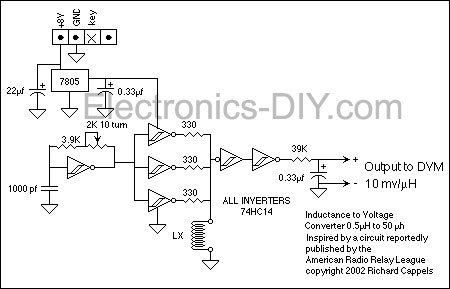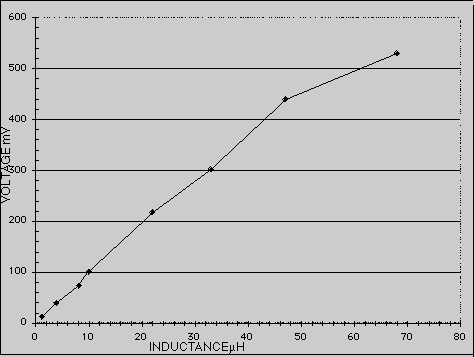| |
This RF inductance meter measures RF chokes in the 500 nH to 50 uH range. I needed a way to measure hand-wound RF inductors in my second lab, and since I would only be doing this occasionally, I didn't need anything fancy, and since once a friend finishes his AT90S1200-based design, I plan to make one myself, I figured I'd use this for less than a year, so I didn't want to invest a lot of time in making it . I had run across the forerunner of this circuit, one that is more sophisticated in that it has a zero adjustment and range switch, but it was limited to higher inductances. I adapted it to the components I had on hand and changed it so that it would work in the 500 nanohenry to 50 microhenry range.The original circuit was reportedly published a few years ago by the Amrican Radio Relay League, so it is with appreciation of the ARRL that I make this circuit available

The circuit's operating principle is that if you make a pulse width proportioal to inductance, and keep the pulse frequency and amplitude constant, and then pass the pulse through a low pass filter so that only the average voltage comes out, the resulting DC voltage is proportional to the inductance.
Stated another way:
Pulse width = Inductance X some constant
DC out = Pulse width X Pulse Ampltude X Freqency
Where DC out and Pulse Amplitude is in volts, and Pulse width is in seconds and pulse frequency is in Hz (1/seconds).
The pulse frequency is set by a schmitt trigger oscillator composed of a feedback resistance (2k pot and 3.9k fixed resistor). a 1000 pf capacitor to ground, and a schmitt trigger. The hysteresis in the schmitt trigger allows it to oscillate with the simple feedback circuit. The pulse width that is proportional to the inductance is made by drving the unknown inductance through a resistor and connecting the resultant sawtooth waveform to the input of another schmitt trigger which, because of the sharp switching action on its output that results from its hysteresis, provides a nice rectangualr pulse. The pulse width is proportional to the inductance and inversely proportional to the resistance. In order to get a pulse with a width that is substantiall longer than the rise and fall time of the schmitt trigger, whcih is a requiremnt for good linearity, while the inductance was in the 500 nH range, I had to use a very low resistance, hence the three 330 ohm resistors and their drivers in parallel. The last inverter in merely to make the pulse positive in polarity so that the voltage increases as the inductance increases.
This circuit is only accurate for broadband inductors. Inductors with iron cores, high permeability ferrites, or with large amonts of shunt capacitance cannot be measured accurately.
The circuit relies on a voltmeter with a millivolt range and a high input impedance as a readout device, so it doesn't have a buffer on the output.
I happned to have the 74HC14 in an SO package so I soldered it onto the metalized side of a prototyping board. If you use a DIP, your life will be much easier. When you built this, keep the connections, including gorund connections, short because tens of nanoseconds count. Pay particular attention to the leads and contacts for LX. Any inductance in that path will add to the measured inductance, so keep it short and small. In the one I built I used a pair of alligator clips soldered to stout wires a couple of cm long.
Calibration:
The procedure is straightforward: Connect a battery and a DVM (digital volt meter), put a known inductor in the LX position then adjust the potentiometer until you get the anticipated reading on the DVM. For example, use a 1 microhenry inductor and adjust the potentiometer to get 100 mv on the DVM.
You might have some trouble getting the thing to calibrate if the switching thresholds on your 74HC14 are very different from the one I used, so you might have to change the resistance in the osicllator or the capacitor in order to claibrate the circuit.
Here are some things to check when calibrating:
-When LX is shorted, the output should be very close to zero volts. If not, you may have too much inductance in the leads to LX or have connected LX to a noisey ground point. There is a remote possibility that you are using a damaged 74HC14, but check this last since it isn't very likely.
-When LX is open, the ouput should be around 2.5 volts (50% of the power supply). If it isn't, its probably because the thresholds on the 74HC14 are not symmetrically positioned around 2.5 volts. Never mind, just adjust the oscillator frequency until you get it to calibrate. If you find the voltage to be very low, say under a volt, then this points to a wriing error, a problem with the 5V regulator or the battery, a damaged 74HC14, or you are using a very low resistance voltmeter. DVMs tend to be 10 Meg Ohms but VOMs (Volt-Ohm-Meters) can be down in the 10K to 20K range and are not suitable for this use.
-The oscillator in the one I made runs at 173 KHz. If yours runs at a greatly different frequency, try changing the oscillator components or try using a 74HC14 made by a different manufacturer.
The circuit gives a pretty constant 10mv/uH through 50 uH.

Related Links
Downloads
RF Inductance Meter - Link
|
|
|
| |
Accurate LC Meter
Build your own Accurate LC Meter (Capacitance Inductance Meter) and start making your own coils and inductors. This LC Meter allows to measure incredibly small inductances making it perfect tool for making all types of RF coils and inductors. LC Meter can measure inductances starting from 10nH - 1000nH, 1uH - 1000uH, 1mH - 100mH and capacitances from 0.1pF up to 900nF. The circuit includes an auto ranging as well as reset switch and produces very accurate and stable readings. |
|
PIC Volt Ampere Meter
Volt Ampere Meter measures voltage of 0-70V or 0-500V with 100mV resolution and current consumption 0-10A or more with 10mA resolution. The meter is a perfect addition to any power supply, battery chargers and other electronic projects where voltage and current must be monitored. The meter uses PIC16F876A microcontroller with 16x2 backlighted LCD. |
|
|
|
60MHz Frequency Meter / Counter
Frequency Meter / Counter measures frequency from 10Hz to 60MHz with 10Hz resolution. It is a very useful bench test equipment for testing and finding out the frequency of various devices with unknown frequency such as oscillators, radio receivers, transmitters, function generators, crystals, etc. |
|
1Hz - 2MHz XR2206 Function Generator
1Hz - 2MHz XR2206 Function Generator produces high quality sine, square and triangle waveforms of high-stability and accuracy. The output waveforms can be both amplitude and frequency modulated. Output of 1Hz - 2MHz XR2206 Function Generator can be connected directly to 60MHz Counter for setting precise frequency output. |
|
|
|
BA1404 HI-FI Stereo FM Transmitter
Be "On Air" with your own radio station! BA1404 HI-FI Stereo FM Transmitter broadcasts high quality stereo signal in 88MHz - 108MHz FM band. It can be connected to any type of stereo audio source such as iPod, Computer, Laptop, CD Player, Walkman, Television, Satellite Receiver, Tape Deck or other stereo system to transmit stereo sound with excellent clarity throughout your home, office, yard or camp ground. |
|
USB IO Board
USB IO Board is a tiny spectacular little development board / parallel port replacement featuring PIC18F2455/PIC18F2550 microcontroller. USB IO Board is compatible with Windows / Mac OSX / Linux computers. When attached to Windows IO board will show up as RS232 COM port. You can control 16 individual microcontroller I/O pins by sending simple serial commands. USB IO Board is self-powered by USB port and can provide up to 500mA for electronic projects. USB IO Board is breadboard compatible. |
|
|
|
|
ESR Meter / Capacitance / Inductance / Transistor Tester Kit
ESR Meter kit is an amazing multimeter that measures ESR values, capacitance (100pF - 20,000uF), inductance, resistance (0.1 Ohm - 20 MOhm), tests many different types of transistors such as NPN, PNP, FETs, MOSFETs, Thyristors, SCRs, Triacs and many types of diodes. It also analyzes transistor's characteristics such as voltage and gain. It is an irreplaceable tool for troubleshooting and repairing electronic equipment by determining performance and health of electrolytic capacitors. Unlike other ESR Meters that only measure ESR value this one measures capacitor's ESR value as well as its capacitance all at the same time. |
|
Audiophile Headphone Amplifier Kit
Audiophile headphone amplifier kit includes high quality audio grade components such as Burr Brown OPA2134 opamp, ALPS volume control potentiometer, Ti TLE2426 rail splitter, Ultra-Low ESR 220uF/25V Panasonic FM filtering capacitors, High quality WIMA input and decoupling capacitors and Vishay Dale resistors. 8-DIP machined IC socket allows to swap OPA2134 with many other dual opamp chips such as OPA2132, OPA2227, OPA2228, dual OPA132, OPA627, etc. Headphone amplifier is small enough to fit in Altoids tin box, and thanks to low power consumption may be supplied from a single 9V battery. |
|
|
|
|
|
Arduino Prototype Kit
Arduino Prototype is a spectacular development board fully compatible with Arduino Pro. It's breadboard compatible so it can be plugged into a breadboard for quick prototyping, and it has VCC & GND power pins available on both sides of PCB. It's small, power efficient, yet customizable through onboard 2 x 7 perfboard that can be used for connecting various sensors and connectors. Arduino Prototype uses all standard through-hole components for easy construction, two of which are hidden underneath IC socket. Board features 28-PIN DIP IC socket, user replaceable ATmega328 microcontroller flashed with Arduino bootloader, 16MHz crystal resonator and a reset switch. It has 14 digital input/output pins (0-13) of which 6 can be used as PWM outputs and 6 analog inputs (A0-A5). Arduino sketches are uploaded through any USB-Serial adapter connected to 6-PIN ICSP female header. Board is supplied by 2-5V voltage and may be powered by a battery such as Lithium Ion cell, two AA cells, external power supply or USB power adapter. |
|
200m 4-Channel 433MHz Wireless RF Remote Control
Having the ability to control various appliances inside or outside of your house wirelessly is a huge convenience, and can make your life much easier and fun. RF remote control provides long range of up to 200m / 650ft and can find many uses for controlling different devices, and it works even through the walls. You can control lights, fans, AC system, computer, printer, amplifier, robots, garage door, security systems, motor-driven curtains, motorized window blinds, door locks, sprinklers, motorized projection screens and anything else you can think of. |
|
|
|